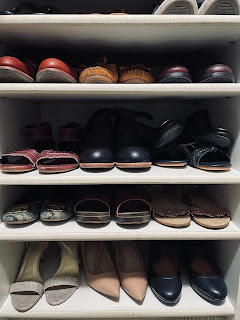Just because something comes to me, doesn't mean it's always for me.
As someone who works with vintage clothing (the buying and selling of it) and someone who loves to wear it as well (half of my closet is vintage - sourcing for vintage can be the biggest job hazard in the world), I've found conflicting concepts are part and parcel to what I do.
Many times, vintage items I find are to be sold.
Many times, vintage items I find are to be mine.
But a big one that has really made an impact on me the last few years is this one: many times, vintage items I find -- even ones that I thought would be mine -- are not always for me.
This sounds counterintuitive. Why not keep something you love? What's inherently wrong with that?
Well, nothing. There's nothing wrong with keeping something I love and can wear or use. But the moment there's a feeling of unease about the item, I know it's not for me.
What do I mean by unease? I'm talking about zero peace.
I can try to get this peace artificially and say to myself "Oh yeah, this is for me. I mean it fits, it looks right, and I've been looking for this for years..." I can have all the reasons, excuses, and validation hallmarks to keep the item. It's for me, it has to be for me!
And yet, the moment I walk away from the item and come back to it, there's a glaring red light coming from it that no one else but I can see.
This red light is the absence of peace. And when I don't have that peace, I know the item isn't for me.
This happens in other areas of my life and covers new (not just vintage) things too. I'm talking about the trip to Target or picking up extra things at Costco.
I'm also talking about things people give to me randomly, or even gifts. Sometimes, I know the gift is to keep. Other times, I hesitate if it's supposed to be mine.
Have you ever gotten something and immediately thought of someone else who could use it or use it better than you ever could? I'm not talking about gifts you don't like.
I'm talking about great gifts like a jacket, or bottle of wine. Or the random bookshelf someone gave you. Random stuff.
And even though you could keep these items, for reasons you can't explain, you second guess keeping it.
Here are a few questions I ask myself and how I assess that feeling of giving to others what isn't for me and why it's all a part of the minimal living movement.
Is this something I need right now? If it is, that's great. It means I don't have to worry I've just acquired something I can't use and I'm not feeling weird about it. No red light glaring at me. Perfect. But sometimes I ask...
Is this something someone else needs right now? This is hard because some items I get I think are for me. But, if my first thought is "This should go to so-and-so," then the item isn't for me to keep. And sometimes I ask both ...
Is this something I could use, but also something someone else needs? Is this replaceable if I let it go? This is the confusing one. But the one to listen to. Often I think the item is for me (and have someone else in mind for it) but I know I'll find another one or be gifted another one sometime in the future. This happens to me all the time.
It's sacrificial giving, but I find it to be the best kind of giving.
The more minimalist I've become, I realize I can live well with less. And living well doesn't mean I need everything I think I need. Sometimes what I receive is meant to be returned to those around me
Of course, there are times when the item I find is for me and it's perfect and it's what I've been looking for. Some days I get what I both need and want. It's not about giving up everything.
And other times, it is about letting go. Right now, I have a purse that I'm going to give away, a mug that I know is not for me, and a sweater I thrifted that I thought I'd be keeping for myself. They're not for me, even though I thought they were.
This can happen with food, clothing, furniture, books, everything! Stuff is just stuff and I'd rather give someone something I can do without that they could use to make their life better.
It is better to get, and give away, than to receive and hold onto something that doesn't belong to me.
If peace isn't a part of your surroundings, then part with it and pare down. Perhaps it is meant for someone else.
Has this happened to you before? Let me know in the comments.
-Heather








